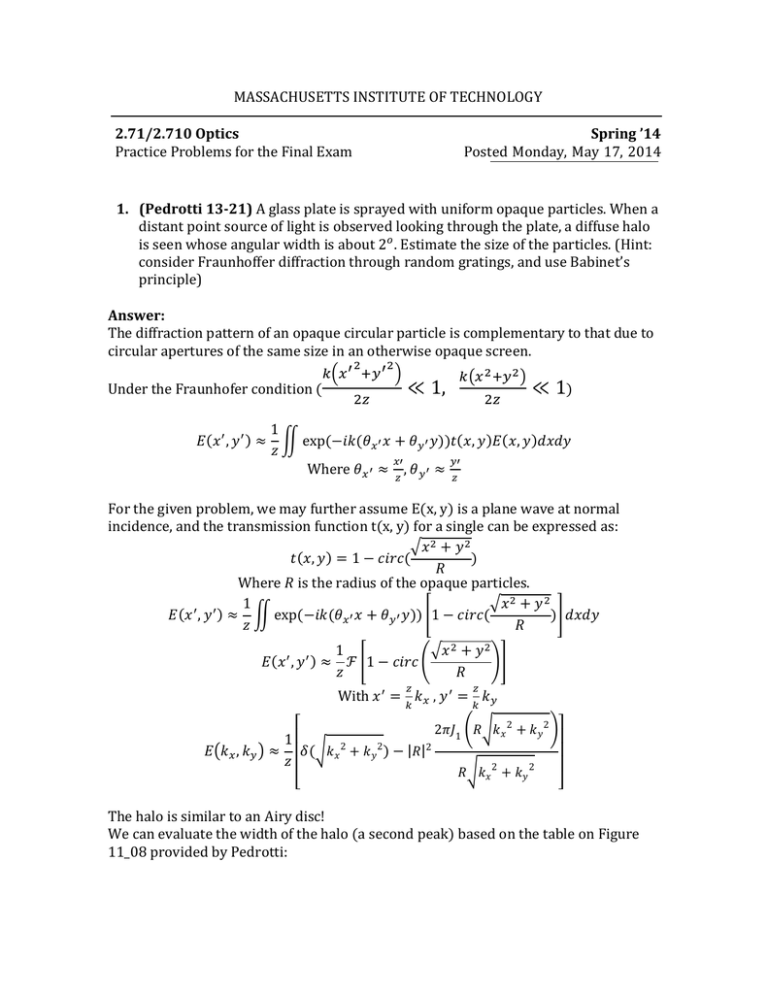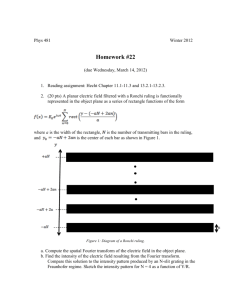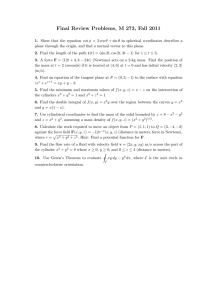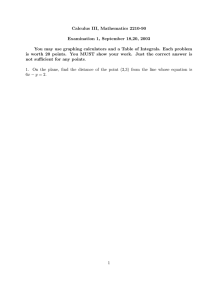
MASSACHUSETTS INSTITUTE OF TECHNOLOGY
2.71/2.710 Optics Practice Problems for the Final Exam
Spring ’14
Posted Monday, May 17, 2014
1. (Pedrotti 13-21) A glass plate is sprayed with uniform opaque particles. When a
distant point source of light is observed looking through the plate, a diffuse halo
is seen whose angular width is about ቄኲ . Estimate the size of the particles. (Hint:
consider Fraunhoffer diffraction through random gratings, and use Babinet’s
principle)
Answer:
The diffraction pattern of an opaque circular particle is complementary to that due to
circular apertures of the same size in an otherwise opaque screen.
ዾ
ዾ
ኮሐኻ ዂ ሎኼ ዂ ሑ
ኮሻኻ ዾ ሎኼ ዾ ሿ
Under the Fraunhofer condition (
ዷ ቃ,
ዷ ቃ)
ሆኽ
ሆኽ
ቃ
ዷሊሤ ሥ ላ ሞ ኅ ቪቢሊሖሕሗሊኰኻ ዂ ሤ ሕ ኰኼ ዂ ሥላላሠሊሤ ሥላዷሊሤ ሥላሐሤሐሥ
ሦ
ኻ
ኼ
Where ኰኻ ዂ ሞ ኽ , ኰኼ ዂ ሞ ኽ
For the given problem, we may further assume E(x, y) is a plane wave at normal
incidence, and the transmission function t(x, y) for a single can be expressed as:
ትሤ ሆ ሕ ሥ ሆ
ሠሊሤ ሥላ ሜ ቃ ሖ ሏሕሞሏሊ
ላ
ሄ
Where ሄ is the radius of the opaque particles.
ቃ
ትሤ ሆ ሕ ሥ ሆ
ዷሊሤ ሥ ላ ሞ ኅ ቪቢሊሖሕሗሊኰኻ ዂ ሤ ሕ ኰኼ ዂ ሥላላ ስቃ ሖ ሏሕሞሏሊ
ላሹ ሐሤሐሥ
ሦ
ሄ
ቃ
ትሤ ሆ ሕ ሥ ሆ
ዷሊሤ ሥ ላ ሞ ኰ ስቃ ሖ ሏሕሞሏ ሽ
ቁሹ
ሦ
ሄ
ኽ
ኽ
ኮ
ኮ
With ሤ ሜ ሗኻ , ሥ ሜ ሗኼ
ኝ
ቄኸዼቃ ሖሄቷሗሤ ቄ ሕ ሗሥ ቄ ሗአ
ቃኞ
ኡ
ዷሻሗኻ ሗኼ ሿ ሞ ኞኬሊቷሗሤ ቄ ሕ ሗሥ ቄ ላ ሖ ዑሄዑቄ
ኡ
ሦ
ኞ
ኡ
ሄቷሗሤ ቄ ሕ ሗሥ ቄ
ኟ
ኢ
The halo is similar to an Airy disc!
We can evaluate the width of the halo (a second peak) based on the table on Figure 11_08 provided by Pedrotti:
© Pearson Prentice Hall. All rights reserved. This content is excluded from our
Creative Commons license. For more information, see http://ocw.mit.edu/fairuse.
Where ካ ሜ ሄቷሗሤ ቄ ሕ ሗሥ ቄ ሜ
ሆዧ
ዢ
ሄኰ.
From the above table,
ቄኸ
ሄኰ ሜ ኴቃቂቈ ሖ ቅኴቊቅቄ ሜ ቅኴቄቆ
ኳ
Taking central wavelength at visible frequency, = 500 nm and given ኰ ሜ ቄኲ we
find the radius of the particle:
ሄሜኳ
ቅኴቄቆ
ቅኴቄቆ
ሜ ቇቂቂሚሙ መ ሜ
ቍ ሜ ቆቈቅሚሙ ሜ ኴቆኴሙ
ቄ
ኰ
ሊቄኸላሆ
ሊቄኸላሆ ሊ
ላ
ቅቈቂ
ቅቈቂ
2. (Adapted from Pedrotti 16-1 and 16-12)
© Pearson Prentice Hall. All rights reserved. This content is excluded from our
Creative Commons license. For more information, see http://ocw.mit.edu/fairuse.
Figure A. Recording(Left) and Reconstruction(Right) of a Gabor Hologram
a) Use the superposition of two beams to show that the recorded intensity
pattern on a Gabor zone-plate (the hologram of a point source) is given
approximately by
ዻ ሜ ዳ ሕ ዴሏማሟ ሆ ሊልሞ ሆ ላ
Where ዳ ሜ ዻህ ሕ ዻሆ ሖ ቄትዻህ ዻሆ , ዴ ሜ ቆትዻህ ዻሆ , and ል ሜ ኸዐሊቄሟኳላ. Here I1 and I2 are
the intensity due to the reference and signal beams, respectively, s is the
distance of the object point from the film, and is the wavelength of the light.
For the approximation, assume the path difference between the two beams is
much smaller than s, so we are looking at the inner zones of the hologram.
Solution: in this problem, two beams are interfering at the zone plate: a reference
plane wave with intensity I1, and a spherical wave with intensity I2. At a distance r
from the symmetric axis, the path difference of the two beams can be written as:
ሞሆ
ኬ ሜ ትሟ ሆ ሕ ሞ ሆ ሖ ሟ ሞ
ቄሟ
Therefore the intensity of the interference pattern can be written as:
ዻ ሜ ዻህ ሕ ዻሆ ሕ ቄትዻህ ዻሆ ሏማሟሊሗኬላ
And
ሗኬ
ሏማሟሊሗኬላ ሜ ቄሏማሟ ሆ ሼ ቀ ሖ ቃ
ቄ
So we can rewrite the intensity into the following form:
ሗኬ
ዻ ሜ ሳዻህ ሕ ዻሆ ሖ ቄትዻህ ዻሆ ሷ ሕ ቆትዻህ ዻሆ ሏማሟ ሆ ሼ ቀ
ቄ
ሗኬ ኸሞ ሆ
ሜ
ቄ
ቄኳሟ
b) (2.710 only) Show that the phase delay of the diverging subject beam, at a
point on the film at distance r from the axis, is given by ኸሞ ሆ ዐመሟ. This results
follows when r<<s. Show also that the amplitude of the light transmitted by
the film under illumination of the reference beam produces converging
spherical wavefront, thus a real image on reconstruction.
Answer:
The path difference ኬ of the diverging beam with respect to the plane wave is
derived in part (a). Therefore the phase delay is:
ሗኬ ሜ
ኸሞ ሆ
ኳሟ
To answer last part of the question we can calculate the Fresnel diffraction pattern of
ኻ
ኼ
this system using ሗኻ ሜ ሗ ኽ , ሗኼ ሜ ሗ ኽ .
ዷሊሤዲ ሥዲላ ሞ ኅ ቪቢሊሕሗ
ሤ ሆ ሕሥ ሆ
ሤ ሆ ሕሥ ሆ
ላ ሚቃ ሕ ቕቡብመሗ
ሙማ ቪቢራሖሕሳሗሤ ሤ ሕ ሗሥ ሥሷሯሐሤሐሥ
ቄሦ
ቄሟ
ቃ
ቃ
ቃ
ሤቄ ሕሥቄ
ላ ሕ ቪቢ መሕሗሻሤቄ ሕሥቄ ሿ ሖ ሕ ሗሙ
ቄሦ
ቄ
ቄሟ ቄሦ
ቃ
ቃ
ቃ
ሕ ቪቢ መሖሕሗሻሤቄ ሕሥቄ ሿ ሖ ሖ ሗሙማ
ቄ
ቄሟ ቄሦ
ዷሊሤዲ ሥዲላ ሞ ኰ ሚቪቢሊሕሗ
The Fourier transform of the first term is straight forward:
ሤዲሆ ሕሥዲሆ
ቪቢ ሖሖሕሗ
ሗኴ
ቄሦ
Likewise, we can express the second and the third term:
ቃ
ሟ ሤዲሆ ሕሥዲሆ
ቃ
ሟ ሤዲሆ ሕሥዲሆ
ቪቢ ሖሖሕሗ
ሗ ሕ ቪቢ ሖሕሗ
ሗኴ
ቄ
ቄሦ ሟ ሕ ሦ
ቄ
ቄሦ ሊሦ ሖ ሟላ
the 3rd term indicates a converging wave front towards z=s (a real image) on
the optical axis.
4. Consider the optical system shown the following schematic, where lenses L1, L2
are identical with focal length f and diameter 2a. A thin-transparency object T1 is
placed at distance 2f to the left of L1.
a) Where is the image formed? Use geometrical optics, ignoring the lens
apertures for the moment.
From the lens formula, we can calculate the location of the image after L1 and L2 as:
1
1 1
, si1 2 f
2 f si1 f
so 2 3 f si1 f
1 1
1
, si 2
f si 2 f
Therefore, the image is located at infinity, to the right of L2.
b) If the object T1 is an on-axis point source, describe the Fraunhofer diffraction
pattern of the field to the right of L2.
The object T1 is imaged to the front focal plane of L2, and therefore is turned into a plane
wave after passing through L2. The Fraunhofer diffraction pattern a uniform plane wave.
c) How are your two previous answers consistent within the approximations of
paraxial geometrical and wave optics?
Answer for (a) obtained with geometrical ray optics matches the answer from (b), which is
obtained from wave optics calculation under the paraxial approximation. Both predicts that
the image after L2 will propagate straight to infinity, in the form of a plane wave.
d) The point source object T1 is replaced by a clear aperture of full width w and a
second thin transparency T2 is placed between the two lenses, at distance f to
the left of L2. The system is illuminated coherently with a monochromatic onaxis plane wave at wavelength λ. Write an expression for the field at distance
2f to the right of L2 and interpret the expression that you found.
A monochromatic on-axis plane wave hits the aperture of full width w at T1. This plane
wave focuses into a point at the focal plane of L1, and is imaged as a point at a distance 2f
away from L2. With no waveplates, a plane wave focuses into a point, at a distance 2f to the
right of L2.
Let us now consider the effect of transparencies. The 2D problem in (x,z) is calculated. The
field on the T1 plane can be expressed as:
T1 ( x1 ) 1 rect (
x1
).
W
The plane wave focuses at the distance f to the right of L1.
Since T2 is located exactly at the image plane of T1, the image of T1 is multiplied to the
transparency T2.
T2 '( x2 ) rect (
x2
) T2 ( x2 )
W
Effectively, this modified transparency is illuminated with a point source located 2f to the
left of L2. At the plane of T2, this illumination can be expressed as:
E ( x2 )
1
j f
jk
jkf
e e
x22
2f
E ( x2 ) E ( x2 )T2 '( x2 )
1
j f
jkf
e e
jk
x22
2f
rect (
x2
) T2 ( x2 )
W
Because T2 is located at the focus of L2, the Fourier transform of ET2 is located at the
distance f to the right of L2.
We jkf
x
EL2 f ( x)
j f exp[ j f x 2 ] sinc(W
) FT{T2 }| x
j f
f
f
At the distance 2f to the right of L2, this field is Fresnel propagated for an additional
distance f, so the analytical expression can be written as:
jkf
jk
e e
EL2 2 f ( X )
j f
X2
f
X
x2
EL2 f ( x) exp[ j 2 x f ]exp[ jk f ]dx .
Qualitatively, this image resembles a point, if T2 does not produce additional spatial
frequency components.
e) Derive and sketch approximately, with as much quantitative detail as you can,
the intensity observed at distance 2f to the right of L2 when T2 is an infinite
sinusoidal amplitude grating of period Λ, such that Λ « a.
With T2 being an infinite sinusoidal amplitude grating,
1
2 x2 1 1 i 2 x2 / 1 i 2 x2 /
.
T2 ( x2 ) [1 cos
e
] e
2
4
2 4
The field after passing through T2 can now be written as:
E ( x2 )
1
jkf
j f
jk
e e
x22
2f
rect (
x2 1 1 i 2 x2 / 1 i 2 x2 /
) e
e
.
W 2 4
4
At the focal plane of L2, the field can be calculated as:
EL2 f ( x)
We jkf
x 1
x
1
x
1 1
x
1
exp[ j f x 2 ] sinc(W
) ( ) (
) (
)
f 2 f
4 f 4 f
f
f
We jkf
x
W j 2
x
1
x
1
) (
)
2 ( ) sinc( ) e
(
f
f
4 f
f
3
3
This represents three delta function sources at the focal plane of L2. At the plane 2f to the
right of L2, the field can be analytically expressed as:
jkf
jk
e e
EL2 2 f ( X )
j f
X2
f
X2
f
We jkf
4 f
f
x
W j 2
x
1
x
1
) (
) ...
2 ( ) sinc( ) e (
f
f
f
X
x2
...exp[ j 2 x
]exp[ jk ]dx
f
f
3
3
f
W j 2
f
X
X
] exp[ j 2 ] exp[ j 2 ]
2 sinc( ) e exp[ j 2
X2
3 f 3
f
jk
j 2 j 2
W
X
f
Ce
sinc( ) sin(2 )
1 e
This is a sinusoidal interference pattern with the periodicity X= , multiplied with a
quadratic phase factor.
2 jkf
jk
e e
4 j 3/2 f 3/2
3
3
MASSACHUSETTS INSTITUTE OF TECHNOLOGY
Problem 5: Zernicke phase mask For problem 1, general formulations for the 4–f
system are presented here. As shown in Fig. A in problem 1, x, x"", and x" are the lateral
coordinates at the input, Fourier, and output plane, respectively. The complex
transparencies at the input and Fourier plane are denoted by t1(x) and t2(x""),
respectively. With on–axis plane illumination, we can formulate as follows:
1. field immediately after T1: t1 (x)
2. field immediately before T2: F [t1 (x)]x→ x''
λf1
3. field immediately after T2: t2 (x"" )F [t1 (x)]x→ x''
λf1
�
�
4. field at the image plane: F t2 (x"" )F [t1 (x)]x→ x''
λf1
""
= F [t2 (x )]x'' →
x'
λf2
�
⊗F F [t1 (x)]x→
x'
λf1
�
'
x
x'' → λf
2
'
x
x'' → λf
2
�
�
f2 "
= F [t2 (x )]x'' → x' ⊗t1 − x ,
λf2
f1
""
(1)
where we use F [F [g(x)]] = g(−x). Note that the field at the image plane is a convo­
lution of the scaled object field and the Fourier transform of the pupil function, where
the FT of the pupil is the point spread function of the system.
Next, it is important to model correctly the transparencies of the gratings. For T1 ,
the phase delay caused by grooves is 2λπ (n − 1)d1 , where d1 is the height of the groove
(1 µm), and the phase profile is shown in Fig. 1. Hence, the complex transparency of
Figure 1: phase profile of the grating T1 (x)
1
T1 is written as
t1 (x) = e
iφ1 (x)
�
�
� �
� ���
2π
x
x
⊗ comb
,
= exp i (n − 1)d1 rect
λ
A1
A2
where A1 = 5 µm and A2 = 10 µm. Hence,
� iπ
e (= −1) if |x| < A1 /2,
t1 (x) =
1
if A1 /2 < x < A2 /2 or − A2 /2 < x < −A1 /2,
(2)
(3)
for |x| < A2 /2. Using the Fourier series (C t1 (x) is periodic) and A = A2 = 2A1 , we
find the Fourier series coefficients as
�
2π
1 A/2
cq =
t1 (x)e−i A qx dx
A −A/2
��
�
� A/4
� A/2
−A/4
2π
2π
2π
1
=
e−i A qx dx −
e−i A qx dx +
e−i A qx dx
(4)
A −A/2
−A/4
A/4
For q = 0, c0 =
For q = 0,
1
A
⎡
J
t1 (x)dx = 0.
�−A/4
�A/4
�A/2 ⎤
2π
�
−i 2π
qx
−i
qx
1 e
e A �
e A ��
�
cq = ⎣
2π �
−
2π �
+
2π � ⎦
A
−i A q �
−i A q �
−i A q �
−A/2
−A/4
A/4
� iπq
π
π
π �
1 e 2 − eiπq e−i 2 q − ei 2 q e−iπq − e−i 2 q
=
−
+
A
q
−i 2π
q
−i 2π
q
−i 2π
A
A
A
�
�
�q �
�q �
i π2 q
−i π2 q
iπq
−iπq
e −e
e −e
=
−
=
sinc
(q)
−
sinc
=
−sinc
.
2
2
i2πq
i2 π2 q
( )
Thus, cq = −sinc 2q + δ(q); all even orders disappear and only odd orders survive.
For the grating T2 , the phase profile is shown in Fig. 2.
−i 2π
qx �
A
(a) phase profile
(b) real part
(c) real part
Figure 2: complex transparency of the grating T2 (x"" )
2
Figure 3: the field immediately before T2 .
The complex transparency can be written as
� "" ��
� "" �
�
� "" �
x
x
x
""
t2 (x ) = rect
− rect
+ irect
.
b
a
a
(5)
a) the intensity immediately after T1 is 1 because |t1(x)|2 = 1. Since T1 is a pure
phase object and there is no intensity variation.
b) the field immediately before T2 can be computed from the Fourier series co­
efficients of t1 (x). Since the period of T1 is A, the diffraction angle of the order q is
θq = q Aλ , and the diffraction order q is focused at f1 θq on the Fourier plane. Hence, the
field immediately before T2 is
�
�
∞
∞
�
�
f1 λ
""
(δ(q) − sinc (q/2)) δ x − q
=
(δ(q) − sinc (q/2)) δ (x"" − q cm) . (6)
A
q=−∞
q=−∞
c) Since b (the width of the grating T2) is 7 cm, the diffraction orders passing
through the grating T2 are q = −3, −1, +1, +3, where −1 and +1 orders get phase
delay of π/2. The field immediately after the grating is
� �
� �
1
3
""
""
i π2
[δ(x"" − 1) + δ(x"" + 1)] .
(7)
−sinc
[δ(x − 3) + δ(x + 3)] − e sinc
2
2
The field at the image plane is the Fourier transform of the field immediately after
the grating T2 , which is computed as
� �
�
�
� �
3
1
""
""
""
""
F −sinc
[δ(x − 3) + δ(x + 3)] − isinc
[δ(x − 1) + δ(x + 1)]
=
2
2
x'
u'' → λf
� � �
�
� � �
�
3
δ(x"" − q) + δ(x"" + q)
1
δ(x"" − 1) + δ(x"" + 1)
− 2sinc
F
− 2isinc
F
=
2
2
2
2
�
�
� �
�
�
� �
−2
3x
2
x
3
1
cos (2πu) = −2
cos 2π
−2i cos 2π
=
−2sinc
cos (2π3u)−2isinc
π
λf2
2
2
3π
λf2
�
�
�
�
4
4
2π
2π
(0.1)x . (8)
cos
(0.3)x − i cos
3π
λ
π
λ
3
The intensity at the image plane is
�
�
�
�
��2
�1
�
2π
2π
�
I(x) ∼ � cos
(0.3)x − i cos
(0.1)x �� =
3
λ
λ
�
�
�
�
1
2π
2π
2
2
cos
(0.3)x + cos
(0.1)x
(9)
9
λ
λ
0.5
0.4
0.45
0.35
0.4
0.3
intensity [a.u.]
intensity [a.u.]
0.35
0.3
0.25
0.2
0.25
0.2
0.15
0.15
0.1
0.1
0.05
0.05
0
-20
-15
-10
-5
0
5
10
15
0
-20
20
x [µm]
-15
-10
-5
0
5
10
15
20
x [µm]
(a) with the phase mask
(b) with the phase mask
Figure 4: intensity pattern at the image plane
Figure 4 shows the intensity pattern at the image plane with and without the phase
mask.
d) In Fig. 4, the phase mask introduces more dramatic intensity contrast, whose
frequency is proportional to the twice of the spatial frequency of the object grating. In
Fig. 4(b), there is a intensity variation but the contrast is smaller. This phase mask is
particularly useful for imaging phase object because phase variation is converted into
intensity variation.
e) In Fig. 4(a), although all the orders are recovered, the field signal is not identical
as the input field (the field immediately after T1). Hence, we may still able to observe
some intensity variation although the contrast could be very limited (but still better
than the case without the phase mask).
f) If a = 0 .5 cm, then the first order does not get the phase delay, and all the orders
are imaged at the image plane. The output field is identical to the input field (the field
immediately after T1); no intensity variation is produced. Intuitively, in Fig. 4(b), as all
the order contribute, the valleys of the intensity pattern is filled and eventually uniform
intensity pattern is produced.
4
(A , of the grating T1
toalternative
ltwan
Another
definition
- PrrLupra
I of - with
if*II solution
I
ie I
1!f")
t/
"-if,oi
s ctnr
a"t
+A,
"^^sb;
-'
/
vt-wlet 1l4L
q^L
rMs., Tt do+t
f**e-"ff*'^o*'t
,lgA^tro-kui;ty
\uru'
"AA"rU&-1t^e-
(u*'{-)
I{il l t
i+ - fX.4(
-
pwioeieJfu
-*fe'"fr
2{ltn1r(fpor
Ie+utoJ= l,z yxl
0t J,^sIL,/* rt, fu
+u!- R*aq.
cI, tl;try +1^*
t,o"d"; - "+tl-i*fkdft
r
t
f .
I
J Nnnula
= ?-'S
!4 tlr
^1
t,Zt I
t?-6T-'
J
L h-ad'rrusn'p , g*r<
=4
, ?zrnz
rr / Lr
Z-fF-e-'v_=n(z)
'7lrr
siJ$lc - L - i?r^*
A
.t
-
, Wc obtqin
I pherc lr
ro
ii Problem Set 3 - page 20
Practice
Vl'r
?1to
Practice Problem Set 3 -
page 21
lto
4tt|],a'i
lsU'u
fn
o
t
0^
e"
T - * a]aa*4n^dtrtg
f *nr*1s&*
I
I
I
I
-dLaappgJw-
-y--
-3)
ry&^v
f c-"?e,np
.
-
l_..
O* r"laralfi dtrw
-.-
X
,T{vr/\
T
,fr
) n,'s
Practice Problem Set 3 -
page 22
f,l-____
#l --
ry 7L nlt^t
-'-
ytt
ry i
t-tfu
tt
- *+{t+-+},
I
z
S,o=1f5
+ =-ur#
=
-t'#F
--5r
-Wqttat- yftTsrirp
:lr-Tryilw
rLl
VM$f
Practice Problem Set 3 -
page 23
-a-^,,r6J
7nqffi-"HW
/
wq ?ry\ -Zf%r-{-ZIffi
r lti-ii
rrtv
l
vt ^.}- a t11,
---i
rl.,_,
i
6ry "'Td w
"
,
7n4ol
II
--t
\
.1r
|
Al..W-ut,
1
,t
i
\rLt
:I
__2
l^nrrff"ry]
J4
MIT OpenCourseWare
http://ocw.mit.edu
2.71 / 2.710 Optics
Spring 2014
For information about citing these materials or our Terms of Use, visit: http://ocw.mit.edu/terms.






